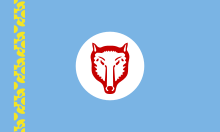Flag of Gagauzia
| Flag of the Gagauz-Yeri | |
|---|---|
 |
|
| Vexillological symbol : | - |
| Aspect ratio: | 1: 2 |
| Officially accepted: | October 31, 1995 |
The Flag of Gagauzia is the official flag of Gagauzia (Gagauz-Yeri) and was the October 31, 1995 by the Gagauz parliament officially confirmed adopted law.
description
The flag consists of three stripes:
- the top stripe is blue and 3/5 the width of the flag
- the middle stripe is white and 1/5 the width of the flag
- The lower stripe is red and 1/5 the width of the flag
Three yellow stars are placed on the blue stripe. The diameter of each star is 3/20 of the flag width and the spacing between the stars is 3/10 of the flag width.
history
With the collapse of the Soviet Union , the Republic of Moldova gained independence in 1991. On August 19, the Gagauz proclaimed their own state. Between 1991 and 1994, a light blue flag with a red wolf's head on a white disc and yellow ornaments on the leech was used in this state . It was first used at an underground meeting in Comrat in October 1989 . In Turkish, the flag was given the name Kökbayrak (Blue Flag).
The Gagauz flag takes up symbols of the Cuman Empire (1061–1240). The light blue symbolizes the sky god Tengri , in whom the ancestors of the Gagauz believed. The name Gagauz was originally Gökoğuz. The word gök comes from Turkish and means heaven, Oğuz means Oghuse. The wolf comes from Turkish mythology . According to the Asena legend , a boy who was the only survivor of a defeated tribe was rescued by a she-wolf. She finally gave birth to twins, half human, half wolf, who became the ancestors of the Gagauz. Because of the legend, the wolf is a symbol of various Turkish national movements, such as the gray wolves .
In 1992 a flag was then officially adopted as the state symbol, which corresponds to the current one. Only the stars were missing. The Gagauz National Museum in Comrat is exhibiting a copy of the flag today. There is also a document from 1993 that shows a black and white drawing of the flag with a symbol instead of the three stars. The first Gagauz government met on July 28, 1993 in what is now the exhibition room.
On December 23, 1994 a partial autonomy of Gagauzia was agreed with the Republic of Moldova. On October 31, 1995, the flag in its current form was finally adopted by the National Assembly with Law No. 2-IV / 1. The unofficial wolf flag can still be found on various websites today. That she represents the Turkic people of the Gagauz, in contrast to the citizens of Gagauz, who also include other ethnic groups, cannot be independently confirmed. The websites in question, however, often have a Turkish national background. The status of a light blue flag with a yellow, black-rimmed disc with a black wolf's head is also unclear. It also seems to come from the time of the Gagauz independence movement around 1990.
Web links
- Flags of the World - Gagauzia (Moldova) (English)
- Vexillographia - Gagauzia (Russian)
Individual evidence
- ↑ a b Gagauzians' origins
- ↑ Gagauzia
- ↑ a b c d Flags of the World - Gagauzia (Moldova)
- ↑ YouTube video: Freedom for Gagauzia - Libertate pentru Găgăuzia
- ↑ Gagauz Türkleri on Facebook
- ↑ Efraasyap: GAGAUZ (GÖKOĞUZ) TÜRKLERİ ( Memento of the original from September 25, 2013 in the Internet Archive ) Info: The archive link was inserted automatically and has not yet been checked. Please check the original and archive link according to the instructions and then remove this notice.

